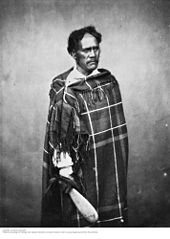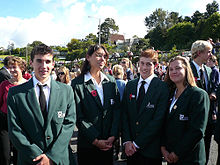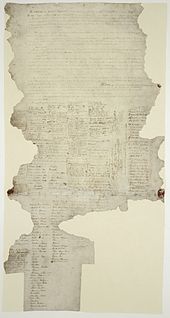New Zealanders
[2] New Zealanders have had a cultural influence on a global scale, through film, language, te ao Māori, art, science, music and technology, and founded the modern women's suffrage and anti-nuclear movements.[16] New Zealanders also pioneered nuclear physics (Ernest Rutherford),[17] the women's suffrage movement (Kate Sheppard), modern Western conceptions of gender identity (John Money) and plastic surgery (Harold Gillies).Some researchers have suggested an earlier wave of arrivals dating to as early as AD 50–150; these people then either died out or left the islands.Māori are active in all spheres of New Zealand culture and society, with independent representation in areas such as media, politics and sport.Following Cook, New Zealand was visited by numerous European and North American whaling, sealing, exploring and trading ships.[50] Following the formalising of sovereignty, an organised and structured flow of migrants from Great Britain and Ireland began, and by 1860 more than 100,000 British and Irish settlers lived throughout New Zealand.Many of the persons of Polish origin in New Zealand arrived as orphans from Eastern Poland via Siberia and Iran in 1944 during World War II.[citation needed] However, when it became clear that not enough skilled migrants would come from the British Isles alone, recruitment began in Northern European countries.There had been people of Asian ethnicity living in New Zealand from the early days of European settlement, albeit in very small numbers.During the period of gold rushes later in the nineteenth century the number of Chinese temporary settlers both from China and from Australia and America increased sharply.However, when the boom times stopped, some blamed the migrants for the economic downturn affecting the country, and many of those people suffered dawn raids from 1974.In 2013, 67,752 people or 1.7% self-identified with one or more ethnicities other than European, Māori, Pacific, Asian, Middle Eastern, Latin American, and African.[24][60] After 1840, many issues to do with sovereignty and land ownership remained unresolved and, for a long time, invisible while Māori lived in rural communities.When Māori and Pākehā (Europeans) began living in closer proximity, the belief that the country had "the best race relations in the world" was tested.[62] In general, New Zealanders of European descent consider themselves to be mostly free of racial prejudice, perceiving the country to be a more inclusive society, a notion that has been challenged especially by members of ethnic minority groups.[68] New Zealanders are distinctive for their twangy dialect of English and propensity to travel long distances, and are quickly associated with the All Blacks rugby team and the haka.The female figure who appears on the left side of the national coat of arms has been identified as Zealandia[71] (in a "cut down nightie").In the New Zealand Wars (1845–1872), the Māori developed elaborate trench and bunker systems as part of the already-existent fortified areas known as pā, employing them successfully as early as the 1840s to withstand British artillery bombardments.The Ngāpuhi pā Ruapekapeka is often considered to be the most technologically impressive by historians, and was described in 2017 as "one of the most sophisticated military installations" the British Empire had ever tackled, by broadcaster Mihingarangi Forbes for RNZ.Instant coffee, today a staple drink across the world, was first invented in Invercargill in 1890 by food chemist David Strang.Sexologist John Money, recognised today as a contentious figure for his experiments regarding children and the David Reimer case, was a pioneer of modern gender identity studies.[82][83] Surgeon and otolaryngologist Harold Gillies is regarded as the father of modern plastic surgery, which he pioneered on soldiers physically dismembered beyond regular care during the First World War.One of the many complications in interpreting religious affiliation data in New Zealand is the large proportion who object to answering the question, roughly 173,000 in 2013.













Demographics of New ZealandFlag of New ZealandWellingtonNew ZealandAustraliaUnited KingdomUnited StatesCanadaNetherlandsUnited Arab EmiratesHong KongGermanyIrelandFranceBrazilEnglishTe Reo MāoriOther minority languagesIrreligiousChristianityAnglicanProtestantismRoman Catholicismother minority religionsAustraliansBritonsMāorihistorycultureNew Zealand Englishits nationality lawethnic makeup of the populationNew Zealanders of European descentScottishMiddle EasternTurkishItalianGermanScandinavianSouth SlavicJewishimmigrationinterracial marriagePasifikamultiracial2013 New Zealand censusIndiansChineseAfrican New ZealandersdiasporaEnglish-speaking countrieslanguagete ao Māorisciencewomen's suffrageanti-nuclearPolynesian navigatorsnavigationastronomytrench warfarenuclear physicsErnest Rutherfordwomen's suffrage movementKate Sheppardgender identityJohn Moneyplastic surgeryHarold GilliesWestern cultureList of ethnic origins of New ZealandersNew Zealand censusEuropeanPacific IslanderAfricanAnzac DayWellington CenotaphMāori peopleTaiwanMelanesiaSociety IslandsChatham IslandsMorioriĪhāia Te KirikūmararangatiraNew Zealand WarsParihakaintermarriageNgāpuhiNgāti PorouNgāi TahuWaikatoAuckland RegionMāori languagekia oraEuropean New ZealandersPākehāBritishGermansPartitions of PolandFrenchSouth SlavsMāori-languageAbel Janszoon TasmanJames CookwhalingsealingPākehā MāoriJames BelichTreaty of WaitangiBay of IslandsNew Zealand CompanyAkaroaSouth IslandStewart Island / RakiuraOtago AssociationMurihikuCanterbury Association"Canterbury Settlement"Indian subcontinentNew Zealand ParliamentEdmund HillaryUnited NationsSecond World WarHungariansRefugees in New ZealandGreece
